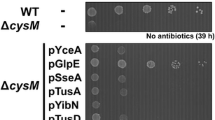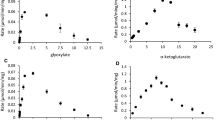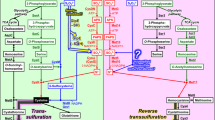Abstract
Selected biochemical features of sulfonate assimilation in Escherichia coli K-12 were studied in detail. Competition between sulfonate-sulfur and sulfur sources with different oxidation states, such as cysteine, sulfite and sulfate, was examined. The ability of the enzyme sulfite reductase to attack the C-S linkage of sulfonates was directly examined. Intact cells formed sulfite from sulfonate-sulfur. In cysteine-grown cells, when cysteine was present with either cysteate or sulfate, assimilation of both of the more oxidized sulfur sources was substantially inhibited. In contrast, none of three sulfonates had a competitive effect on sulfate assimilation. In studies of competition between different sulfonates, the presence of taurine resulted in a decrease in cysteate uptake by one-half, while in the presence of isethionate, cysteate uptake was almost completely inhibited. In sulfite-grown cells, sulfonates had no competitive effect on sulfite utilization. An E. coli mutant lacking sulfite reductase and unable to utilize isethionate as the sole source of sulfur formed significant amounts of sulfite from isethionate. In cell extracts, sulfite reductase itself did not utilize sulfonate-sulfur as an electron acceptor. These findings indicate that sulfonate utilization may share some intermediates (e.g. sulfite) and regulatory features (repression by cysteine) of the assimilatory sulfate reductive pathway, but sulfonates do not exert regulatory effects on sulfate utilization. Other results suggest that unrecognized aspects of sulfonate metabolism, such as specific transport mechanisms for sulfonates and different regulatory features, may exist.
Similar content being viewed by others
References
Clark HT, Inouye JM (1931) The alkaline deamination of derivatives of cysteine. J Biol Chem 94: 541–550
Dreyfus J, Monty KJ (1963) Coincident repression of the reduction of 3′-phosphoadenosine 5′-phosphosulfate, sulfite, and thiosulfate in the cysteine pathway of Salmonella typhimurium. J Biol Chem 238: 3781–3783
Grant WM (1974) Colorimetric determination of sulfur dioxide. Anal Chem 19: 345–346
Ikeda K, Yamada H, Tanaka S (1963) Bacterial degradation of taurine. J Biochem 54: 312–316
Kondo H, Anada H, Ohsawa K, Ishimoto M (1971) Formation of sulfoacetaldehyde from taurine in bacterial extracts. J Biochem 69: 621–623
Kredich NM (1987) Biosynthesis of cysteine. In: Neidhardt FC (ed) Escherichia coli and Salmonella typhimurium. Cellular and molecular biology. American Society for Microbiology, Washington DC, pp 419–427
Lowry OH, Rosebrough NJ, Farr AL, Randall RJ (1951) Protein measurements with Folin phenol reagent. J Biol Chem 193: 265–275
McLaggan D, Epstein W (1991) Escherichia coli accumulates the eukaryotic osmolyte taurine at high osmolarity. FEMS Microbiol Lett 81: 209–214
Pasternak CA, Ellis RJ, Jones-Mortimer MC, Crichton CE (1965) The control of sulphate reduction in bacteria. Biochem J 96: 270–275
Roberts RB, Abelson PH, Cowie DB, Bolton ET, Britten RJ (1957) Studies of biosynthesis in Escherichia coli. Carnegie Institution of Washington, Washington DC, pp 318–405
Seitz AP, Leadbetter ER, Godchaux W III (1993) Utiization of sulfonates as sole sulfur source by soil bacteria including Comamonas acidovorans. Arch Microbiol 159: 440–444
Shimamoto G, Berk R (1979) Catabolism of taurine in Pseudomonas aeruginosa. Biochim Biophys Acta 569: 287–292
Stapley E, Starkey R (1970) Decomposition of cysteic acid and taurine by soil microorganisms. J Gen Microbiol 64: 77–84
Uria-Nickelsen MR, Leadbetter ER, Godchaux W III (1993) Sulphonate utilization by enteric bacteria. J Gen Microbiol 139: 203–208
Wheldrake JF (1967) Intracellular concentration of cysteine in Escherichia coli and its relation to repression of the sulphate-activating enzymes. Biochem J 105: 697–699
Wu J-Y, Siegel LM, Kredich NM (1991) High-level expression of Escherichia coli NADPH-sulfite reductase: requirement for a cloned cysG plasmid to overcome limiting siroheme cofactor. J Bacteriol 173: 325–333
Author information
Authors and Affiliations
Rights and permissions
About this article
Cite this article
Uria-Nickelsen, M.R., Leadbetter, E.R. & Godchaux, W. Comparative aspects of utilization of sulfonate and other sulfur sources by Escherichia coli K12. Arch. Microbiol. 161, 434–438 (1994). https://doi.org/10.1007/BF00288955
Received:
Accepted:
Issue Date:
DOI: https://doi.org/10.1007/BF00288955




